- MIDDLE ARMS
- See under arms.
- MILITARY BANNER
- See banner 5) (also
sovereigns banner).
- MILITARY CREST
- In largely US usage, the term for that emblem which is displayed by units of the National Guard,
and usually taken from symbols contained within the flags, seals and/or coats of arms of the relevant
state a state military crest (see also
badge 3),
coat of arms,
emblem, military and governmental,
seal and
state flag 2).
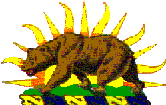


Military Crest of California, US (fotw); Military Crest of Texas, US (fotw);
Military Crest of Maryland, US (fotw)
- MIXED TINCTURES
- See Appendix III.
- MIZZEN
- The aftermost mast in a sailing vessel with three or more masts (and on a two masted vessel dependent upon the rig) from which the gaff is rigged, and from which
the command flag of a rear-admiral was formerly flown (see also
flag of command,
fore,
gaff, mast and
masthead).
- MOLINE CROSS
- See cross moline in appendix VIII.
- MON
- A simple often (but not exclusively) circular design and the Japanese equivalent
of a heraldic badge or shield, originally a personal or family symbol, they are now
also common in Japanese civic flags (see also
daimyo flags and,
hinomaru).
![[Mon on Japanese flag]](../images/v/vxt-d213.gif)
Flag of Aogashima Island, Japan (fotw)
- MONOGRAM
- A motif formed by one or more letters, formerly often intertwined and now
more usually seen plain, as for example, on the royal standard of Belgium and
some presidential flags of France a cipher or ligature (this last especially
if of only two letters).
|
![[Monograms on flags]](../images/v/vxt-d215.gif)
Belgium (fotw)
|
![[Monograms on flags]](../images/v/vxt-d215a.gif)
France 1969 74 (fotw)
|
- MOON
- 1) In vexillology see crescent 1) and disc.
- 2) In heraldry the term used for a crescent that is placed vertically but see note below and
crescent 2).
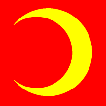
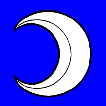
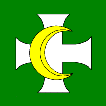
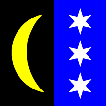
Flag of Oran-laville, Switzerland (fotw); Flag of Bόren an der Aare, Switzerland (fotw);
Flag of Cortaillod, Switzerland; Flag of Schinznach, Switzerland
Please note with regard to 2) that when a crescent moon is shown with its
horns towards the dexter it is termed increscent or increment, when towards the sinister decrescent or
decrement, when however, it is shown full (usually with a face) the term used is per complement.
Also please note that a crescent with a face is not unknown in
European heraldry.
- MORNING COLOURS (or COLORS)
- See colours 5).
- MORSE CODE SIGNALLING WITH FLAGS
- 1) The current system of signalling with flags (or with the arms alone in the absence of
flags) using the Morse code, where if hand-held vertically (above the head) they signify
dots and if held horizontally (at shoulder level) dashes (see also
international code of signals,
semaphore and
wigwag).
- 2) A system, now obsolete, of signalling with a single flag using the Morse code, where
short waves signified dots and long waves dashes - signalling by flag waving (see also
semaphore and
wigwag).
Please note that 1) is contained in the current (2005) Edition of the International Code
of Signals, and that 2) had reasonably widespread use in the field prior to radio, both
between artillery batteries and forward observers, and for communication between naval and
army units ashore. Please note also that the 1937 (British) Admiralty Manual of Seamanship
gave the Morse code flags as plain blue, or white with a blue horizontal stripe (against
light or dark backgrounds respectively), but that other variants are known to have
existed.
- MOTTO
- A word or phrase, sometimes in a classical language, usually inscribed on
the scroll accompanying a coat of arms or state emblem, and originally derived
from the war cry (see also Appendix IV,
device 1) and
scroll).
- MOUNT
- A heraldic term for the base of a shield, banner of arms or a flag that forms a curve,
and is generally (but not exclusively) tinctured vert in order to represent a grassed hillock
see compartment (also coupeau, tinctures and vert).

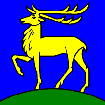


Flag of Obrehrendingen, Switzerland; Flag of Merenschwand, Switzerland; Flag and Arms of Brdovec, Croatia (fotw)
- MOUNT OF COUPEAU
- See coupeau (also mount above).
- MOURNING FLAG
- An often (but not invariably) plain black flag of slightly varying design, displayed (sometimes
unofficially) by organisations and persons to signify mourning for people or events,
often (but not invariably) for political reasons not to be confused with a
mourning pennant, pall
flag or funeral flag (see funeral flags,
mourning pennant below
and pall flag, also
cravat 2),
draping
and 'half mast a flag').



From left: Croatia (CS); Denmark (CS); Demark until 1743 (fotw); Vietnam
(fotw)
- MOURNING PENNANT
- In Western European usage, a largely black triangular pennant of slightly varying design, flown from the mainmast
of vessels on inland waterways to signify mourning for the skipper or his spouse (see also
mourning flag above).
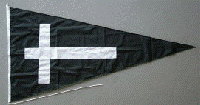
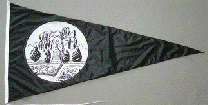
Catholic and Protestant Mourning Pennants (Litzke GmbH)
- MOURNING RIBBON
- See draping (also
cravat 2)).
- MULLET
- See star 2).
- MULTI-STRIPE
- 1) A flag of four or more parallel stripes or bands, whether horizontal, vertical or
diagonal, and of equal or unequal width. (see also plain 2),
stripe and striped)
- 2) A flag of four or more horizontal parallel stripes or bands of equal width,
width a horizontal multi-stripe but see barry in appendix VI (also
covering).
- 3) A flag of four or more vertical parallel stripes or bands of equal width a
horizontal multi-stripe but see paly in appendix VI (also
covering).
- 4) A flag of four or more diagonal parallel stripes or bands of equal width, also bendy
if they go from the upper hoist to the lower fly or bendy sinister if from the
lower hoist to the upper fly a diagonal multi-stripe but see bendy and
bendy sinister in appendix VI.
Please note however, that on certain flags (as in
those of - for example Botswana, The Gambia or North Korea) there is often no
clear distinction between a fimbriation and a stripe, and that the terms multi-stripe
or fimbriated tricolour/triband (or similar) may reasonably be used as alternatives
in describing such flags (see also Appendix VI,
fimbriation and
stripe).
![[Multi-stripe flags]](../images/v/vxt-d219.gif)
From left: Civil Flag of Costa Rica (fotw); National Flag of
Mauritius (fotw); Power Squadrons, US (fotw); Flag of Friesland, Netherlands (fotw)
- MULTI-TAILED (or TONGUED)
- (adj) A term used to describe a fly that is cut into more than three tails or tongues
(see also gonfanon,
square-tongued,
swallowtail and tongue and
tongue(s)).
- MULTI-TAILED DESCATE
- (adj) A term used to describe a fly that is cut into more than three tails
with rounded ends (see also
double-tailed descate,
fly,
gonfanon,
square-tailed',
swallow-tail(ed)
swallowtail and tongue and
tongue(s)).
- MUNICIPAL FLAG
- See civic flag 1).
- MURAL CROWN
- 1) Generically the heraldic term for a crown composed of battlemented walls showing masonry and
generally from three to five towers, usually (but not exclusively) representative of a municipality
or urban area (see also
astral crown,
coronet,
crown,
and naval crown).
- 2) Specifically the heraldic term for a crown with masoned, battlemented walls but without
towers, often representative of a town or city and reputedly based on an ancient
Roman triumphal ornament - but see civic crown 1)
also astral crown,
coronet
crown) and
naval crown.
Please note that in some European heraldic systems,
the number of crenellations is dependent upon the size and civic status of the
municipality represented.
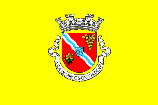
![[mural crown]](../images/v/vxt-d221.gif)
Flag of Arcos de Valdevez, Portugal (fotw); Heraldic Mural Crown (Parker)
Please note that in some European heraldic systems, the number of towers
and/or the number of crenellations is dependent upon the size and civic status of the municipality
represented.














![[Multi-stripe flags]](../images/v/vxt-d219.gif)

![[mural crown]](../images/v/vxt-d221.gif)

![[Mon on Japanese flag]](../images/v/vxt-d213.gif)
![[Monograms on flags]](../images/v/vxt-d215.gif)
![[Monograms on flags]](../images/v/vxt-d215a.gif)

